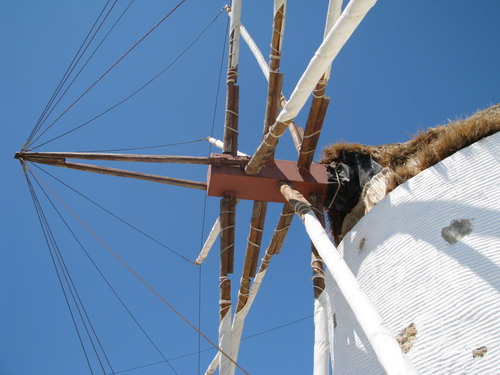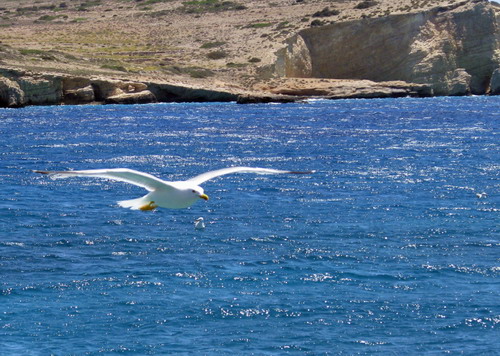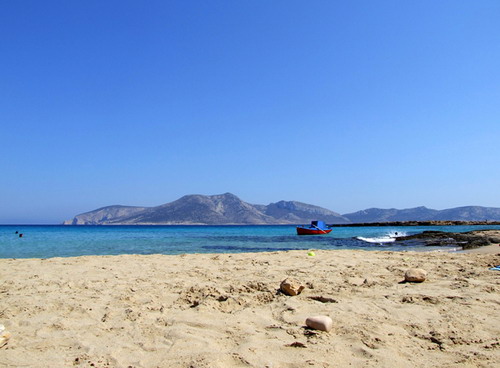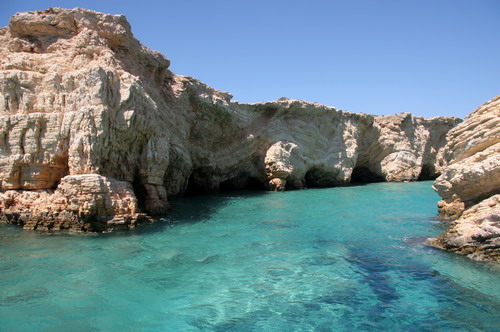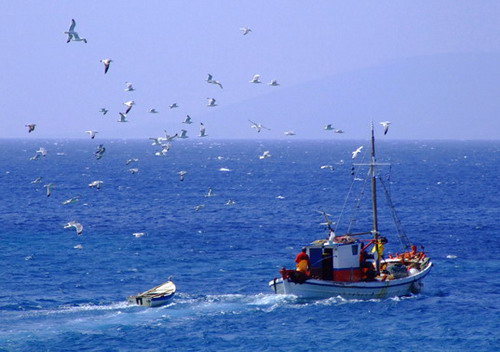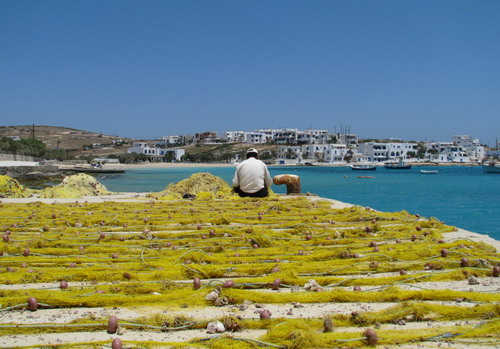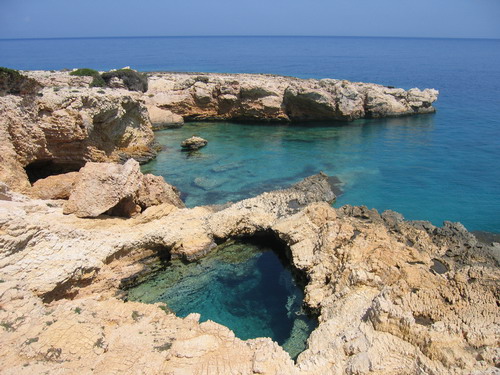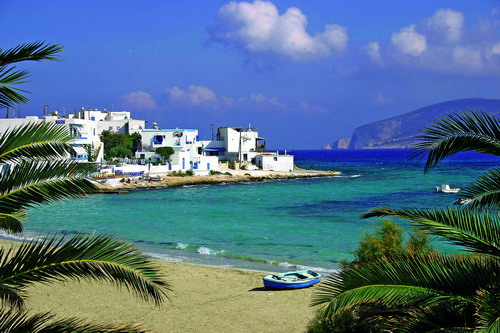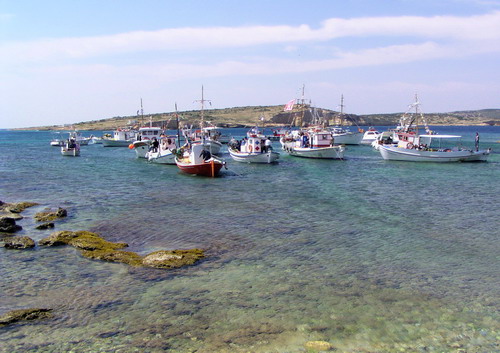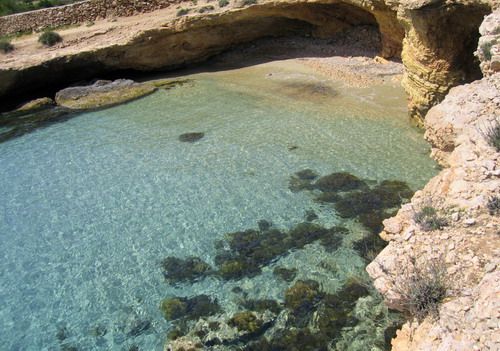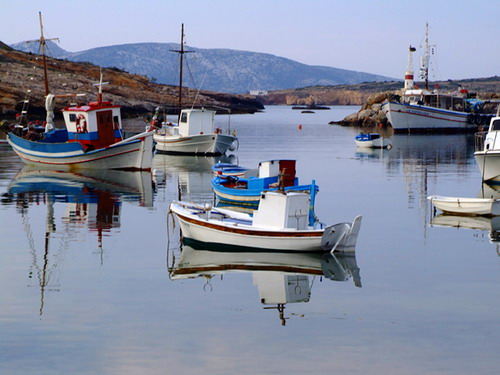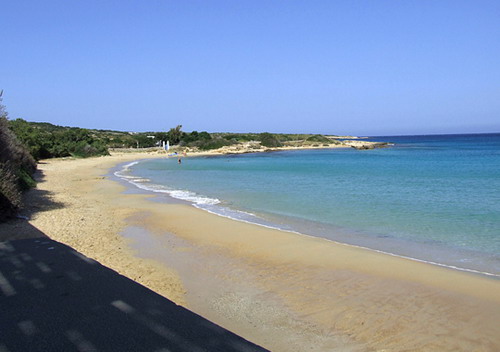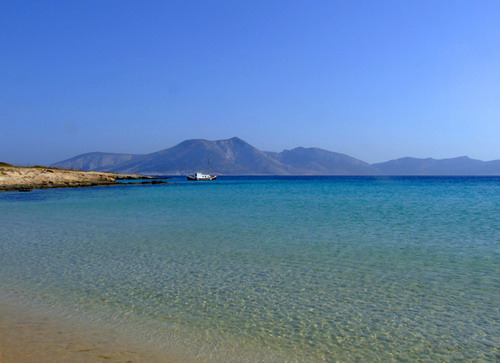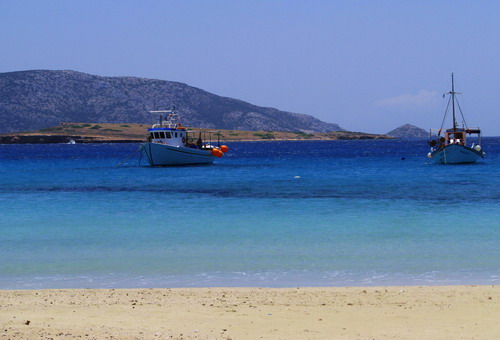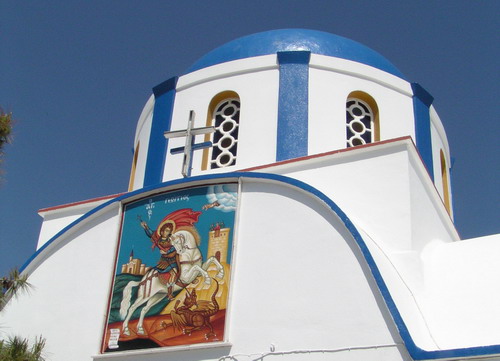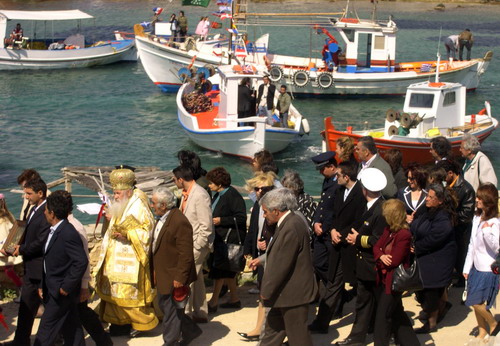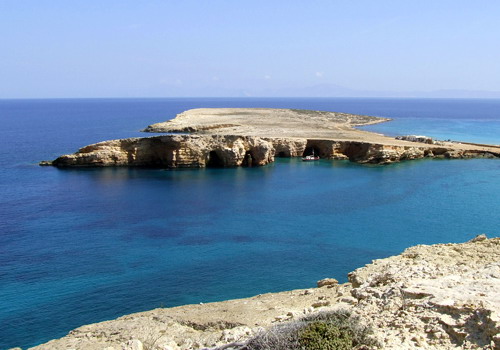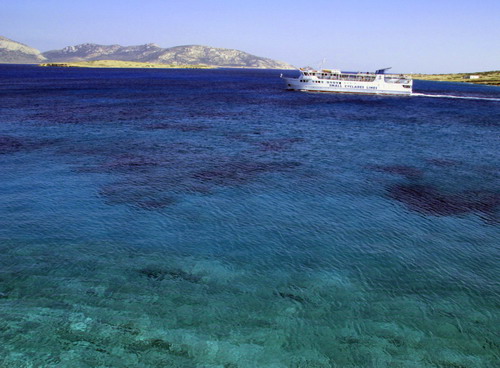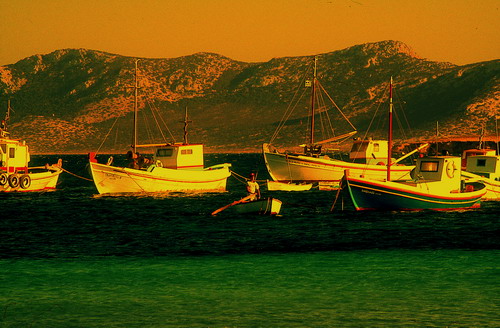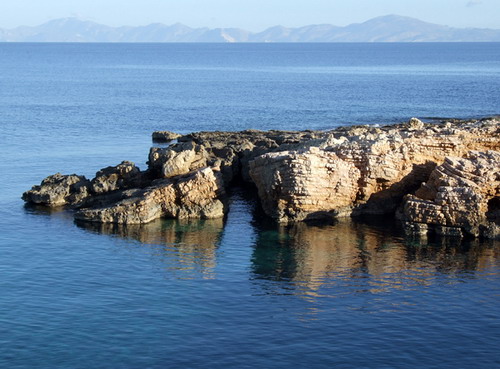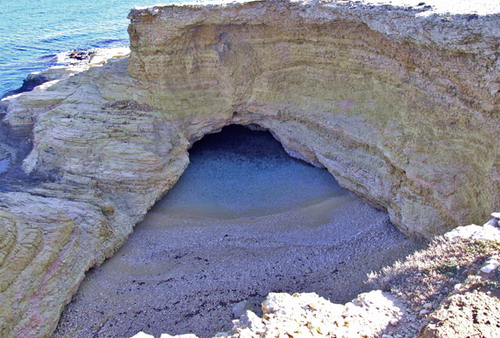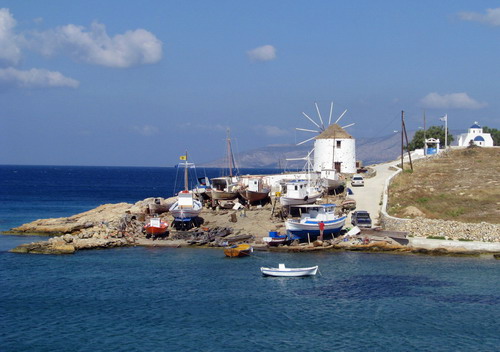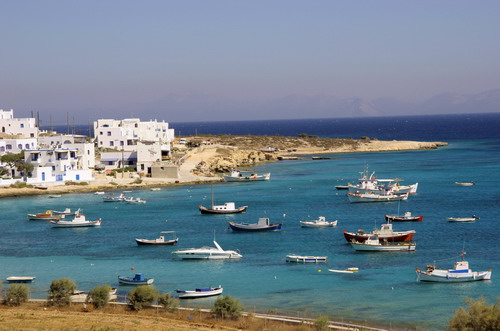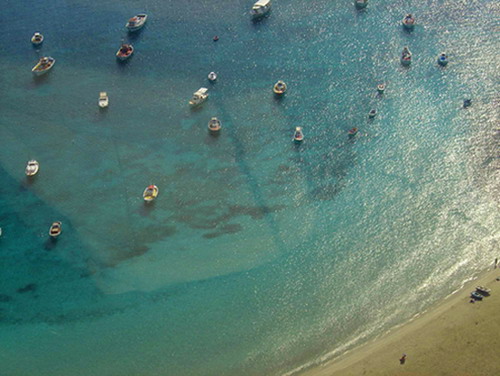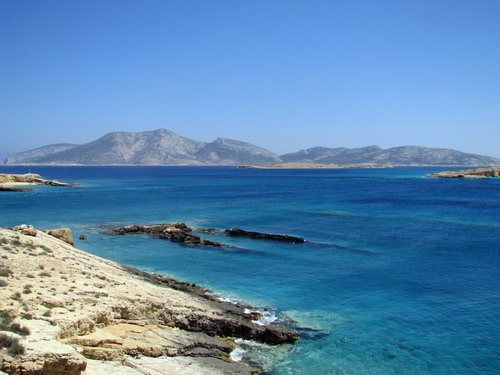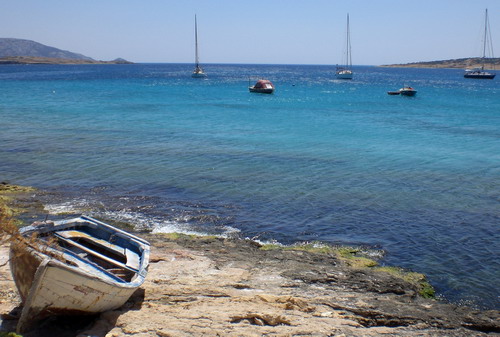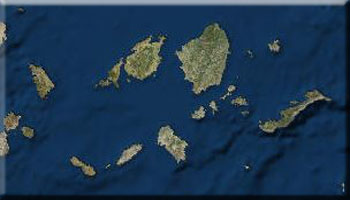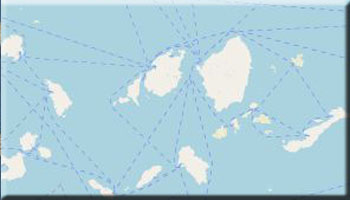The Koufonisia, two small islands separated by a 200-meter straight, lie southeast of Naxos and west of Amorgos. Pano Koufonisi, more widely known simply as Koufonisi, is the smallest of the Cyclades, with an area of 3.5 square kilometers. But with 284 inhabitants, it's also the most densely-populated. Uniquely for a Greek island, Koufonisia's population has a large proportion of youths-110, including 70 in primary or secondary school.
Fishing is the island's main economic activity. Limited farming and livestock-keeping is only sufficient to meet locals' needs. Fishing is so widespread that locals joke that there are more fishing boats than families on the island. The local fishing fleet numbers 35 large boats, plus a number of smaller octopus boats and other fishing craft; per capita, it is the largest fishing fleet in Greece.
Koufonisia has only recently been discovered by tourists so the island remains virtually unspoiled. Although it's now become more difficult to find a totally secluded beach, the islands' golden sand and shimmering seas amply reward visitors. Arriving, a white-washed windmill rising on the harbor's left welcomes visitors, beckoning them to explore Hora perched on the hill above.
Locals are so welcoming that visitors to the island usually feel like guests. Many will offer transport on their pickup to one or more remote beaches, while the cost of chartering a fishing boat for a trip to Kato Koufonisi, Glaronisi, or a secluded beach is quite reasonable. Food and accommodations are also reasonably priced. Amenities and services on the island include a post office, a number of restaurants and tavernas, hotels, and rental rooms (in Hora and Harokopou).
There's regular boat service linking Koufonisia to Piraeus and Rafina and daily service to nearby islands-Ios, Santorini, Amorgos, Naxos, Paros, Mykonos, and Syros. In winter, sailings are limited to a local network-Amorgos, Donousa, Koufonisi, Schoinoussa, Irakleia, Naxos-served by the boat Skopelitis.
Koufonisia have been inhabited continuously since Prehistoric times. Excavations at Epano Myloi unearthed important funerary finds from the early Cycladic civilization. The most important, a pan-shaped vessel inscribed with a star, is exhibited at the Naxos Archaeological Museum. Excavations on southern end of the eastern coast unearthed Hellenistic and Roman finds. Nearby Keros, which is worth visiting, was also an important center of Cycladic culture (3000-2000 B.C.).
Koufonisia subsequently shared the fate of most of the islands in the Cyclades group which suffered from frequent raids by pirates. The isles' control passed between Venetian dynasties and the Ottomans, and Koufonisia was often forced into alliance with pirates from Mani or elsewhere who took shelter in the strait between Pano Koufonisi and Kato Koufonisi.
In the 17th century, as the clashes between Venice and Turkey for control of the seas peaked, Koufonisia was pushed even deeper into poverty. Faced with starvation, inhabitants survived by eating various bulbous plants growing wild on the island, including the lupins on which animals grazed.
Koufonisia was liberated after the 1821 revolt with the rest of the Cyclades.
Keros: A rocky isle southeast of Koufonisia, one of the most important centers of Cycladic culture (3000-2000 B.C.). Excavations on the western end yielded priceless finds, including 100 marble figurines. Two—the Harpist and the Flutist—are exhibited in the collection of the National Archaeological Museum in Athens; another is the 1.4-meter figurine of a mother-goddess.
Keros in some ancient texts such as Homer and the Orphica is identified with Asteria, the island that some myths claim was the birthplace of Apollo and Artemis. Some scholars claim that the unique Cycladic figurines were inspired by the isle’s shape, which resembles that of a reclining female form. Keros is spectacular at sunset as light and shadows dance over the land’s relief. When the moon is full, it falls on the island’s profile in such a way that viewed from Koufonisia, Keros looks like a female form floating on the sea.
Koufonisia is an experience, an escape from the routine of day to day living. Locals are genuinely hospitable. Tavernas serve fresh fish at reasonable prices, though amateur fishermen enjoying catching their meal themselves as there is good fishing off the rocky caves. There is no need for transport as every part of the island is reached easily on foot. Fishing boats can be rented for visits to neighboring islands, making Koufonisia ideal for forays to the rest of the Lesser Cyclades.
From Parianos in the west to Pori on the east, the island has a number of charming beaches. Coves of golden sand alternate with rocky outcrops and caves carved over millennia by the sea.
Moving east along the island, beaches are prettier and vegetation relatively denser. A footpath traces the coast leading visitors to the beach of their choice.
Harakopou and Platia Pounta are the most popular beaches, while Fanos is the most tranquil and Pori is the most remote-and for some, also the island's best beach. Pori is about 4 kilometers from Hora but worth the trek.
The coastal road is longer than it looks on the map, and the route through the interior is prettier. The coastal footpath is framed by low dunes with sea daffodils, a pretty flower found on Cyclades beaches.
Fishing boats can also be hired for trips to Kato Koufonisi, where there are beaches of coarse sand that are ideal for nude bathing.
The feast of Ayios Yeoryios, the island's patron saint, is observed with a procession of the saint's icon around the island. Streets are strewn with flowers for the occasion, while the procession's route is followed, from sea, by fishing boats until its return to the church. Services are followed by a communal meal of boiled beef, which evolves into a traditional glendi with singing and dancing in the tavernas.
Holy Week and Easter are special as they involve the entire island. On Good Friday, the island is illuminated by candles and the resurrection service at midnight on Saturday is followed by fireworks.
The Fisherman's Feast on the last Saturday of June takes place in the streets and square. Tavernas are closed so that everyone can join in a communal meal of fresh fish and fish dishes, washed down with wine and accompanied by music and dancing.
The feast of Profitis Ilias on July 20 is also observed with a glendi-food, wine, music, and dancing.
The Dormition of the Virgin on August 15 is observed with services at the church of Panayia at Kato Koufonisi, where islanders are transported by fishing boat. Services are followed by a fish fry (or sometimes a meal or lamb or goat). Fishing boats race during the return; winners and losers trade toasts as the paniyiri continues in the evening with music and dancing.
| COMMUNITY OF KOUFONISIA | 22850 71379 |
| CITIZENS SERVICE BUREAU (KEP) | 22850 29243 |
| MEDICAL CENTRE | 22850 71370 |









